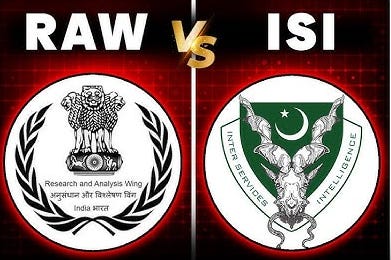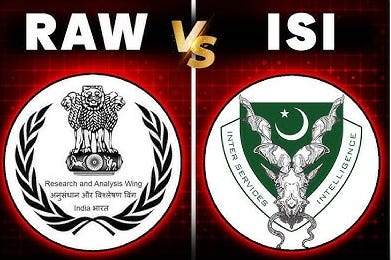India-Pakistan Tensions and the Intelligence Rivalry of ISI vs RAW
By Ujasusi Blog Team May 11, 2025
India-Pakistan tensions have entered a dangerous new phase in 2025, marked by cross-border strikes, proxy warfare, and deepening animosity between their two premier spy agencies: India’s Research and Analysis Wing (RAW) and Pakistan’s Inter-Services Intelligence (ISI). This article explores how this intelligence rivalry influences the broader conflict, focusing on ongoing developments, cyber warfare, propaganda campaigns, and espionage operations.
Background: Intelligence Agencies Shaping Geopolitical Hostility
The history of the RAW-ISI rivalry is integral to understanding India-Pakistan relations. Since the partition of British India in 1947, both nations have fought multiple wars and engaged in persistent low-intensity conflicts. To support their strategic objectives, both countries invested heavily in intelligence operations. Pakistan established ISI in 1948 to protect military interests and counter Indian influence. In response, India created RAW in 1968 to safeguard national security, particularly from Pakistan-backed insurgency.
The agencies have long been accused of supporting proxy wars. ISI allegedly sponsored armed separatist movements in Punjab and Kashmir, while RAW played a pivotal role in Bangladesh's liberation in 1971 and is accused by Pakistan of fomenting unrest in Balochistan. These historical legacies underpin the covert warfare strategies seen today.
Current Escalation: 2025 Crisis and Operation Sindoor
In April 2025, the security climate deteriorated sharply after a major terrorist attack in Pahalgam, Kashmir, left 25 Indian tourists and one Nepali national dead. India promptly blamed Pakistan-based group Lashkar-e-Taiba and cited RAW intelligence linking the operation to ISI-supported handlers.
India launched "Operation Sindoor" in May 2025, conducting precision strikes on what it identified as terrorist launchpads in Pakistan-administered Kashmir. RAW's signals intelligence (SIGINT) and satellite surveillance allegedly provided targeting data. Pakistan retaliated diplomatically and militarily, vowing a proportional response while increasing troop deployments near the Line of Control.
As of mid-May 2025, both nations have recalled top envoys and suspended consular operations. Intelligence sources suggest ISI is orchestrating regional disinformation campaigns targeting India, including fake news, AI-generated deepfakes, and foreign lobbying. Meanwhile, RAW is reportedly coordinating counterintelligence operations and preemptive arrests of suspected Pakistani operatives in major Indian cities.
Kashmir: A Focal Point of Intelligence Warfare
Kashmir remains the primary theatre of RAW-ISI confrontation. India accuses ISI of arming and directing jihadist groups like Lashkar-e-Taiba and Jaish-e-Mohammed to destabilise the region. The Pahalgam attack reignited concerns over cross-border infiltration allegedly facilitated by ISI operatives.
RAW has enhanced surveillance using high-resolution drones and AI-assisted facial recognition to track insurgent movement across the Line of Control. Intelligence-led raids have reportedly disrupted sleeper cells in Jammu and Kashmir, foiling potential attacks in Delhi and Mumbai.
ISI, for its part, denies involvement in terrorism and frames the unrest as an indigenous uprising. It continues to exploit local grievances through cyber-psychological operations aimed at eroding public trust in Indian security forces. According to intelligence briefings, ISI also maintains a network of informants and overground workers inside Kashmir.
Balochistan and Beyond: Pakistan's Internal Threat Narrative
Pakistan often accuses RAW of financing and arming separatist groups in Balochistan, especially the Baloch Liberation Army (BLA). In March 2025, a deadly ambush on a military convoy in Quetta was blamed on RAW-sponsored operatives, though no definitive proof was made public.
India denies involvement and claims Pakistan uses Balochistan as a scapegoat to divert attention from domestic governance issues. However, Islamabad continues to portray Kulbhushan Jadhav, arrested in 2016 and accused of espionage in Balochistan, as evidence of India's covert sabotage strategy.
Afghanistan also remains a battleground for intelligence activities. RAW's past presence in Kabul was viewed as strategic encirclement by ISI, which cultivated deep ties with the Taliban. Though the U.S. withdrawal altered the dynamics, both agencies are believed to be manoeuvring for influence through local actors.
Espionage Scandals and Surveillance Operations
In recent years, both ISI and RAW have increased human intelligence (HUMINT) and counterintelligence missions:
Kulbhushan Jadhav Case (2016-present): A focal point of propaganda and legal confrontation, with Pakistan alleging state-sponsored espionage by India.
Diplomatic Expulsions (2020): Both nations expelled diplomats on espionage allegations, degrading formal communication channels.
Honey Trap Operations: ISI has exploited online platforms to extract sensitive information from Indian military personnel. At least six such arrests were made in 2023–24.
Spy Ring Busts: RAW and IB continue to disrupt Pakistani espionage networks, particularly in Rajasthan, Punjab, and West Bengal. Arrested individuals are often found relaying troop movements and infrastructure layouts to handlers in Karachi and Rawalpindi.
These operations showcase the ongoing intelligence struggle for battlefield advantage, technological supremacy, and strategic deterrence.
Cyber Espionage and Digital Warfare
Cyberspace has become the newest frontier of the ISI-RAW conflict. Both nations possess offensive cyber units conducting espionage, surveillance, and sabotage operations:
Pakistani APTs: Groups such as APT36 and Transparent Tribe, with alleged ISI backing, have targeted Indian defence and research sectors using spyware and spear-phishing.
Indian Cyber Response: India-linked groups like "SloppyLemming" and "SideCopy" have conducted campaigns against Pakistani military email servers and utility grids.
Critical Infrastructure Threats: India reported a power grid intrusion attempt in Gujarat and suspected Pakistani actors. Pakistan claims Indian hackers attempted to breach aviation and water purification systems.
Social Media Warfare: Both nations deploy bot farms, meme brigades, and fake influencers to shape public discourse, trigger unrest, and flood opposing platforms with nationalistic content.
Cyber warfare offers high-impact, low-cost tools for intelligence agencies to carry out psychological and digital subversion with plausible deniability.
Disinformation, Propaganda, and Perception Management
Both RAW and ISI engage in sophisticated information warfare to control narratives domestically and internationally:
RAW's Global Messaging: Through diplomatic briefings, think tank engagement, and diaspora networks, RAW supports India’s portrayal as a victim of cross-border terrorism.
ISI's Psychological Operations: Leveraging platforms like YouTube and TikTok, ISI amplifies Kashmir-related content, often accompanied by manipulated visuals and unverifiable footage.
Narrative Wars in Multilateral Forums: Each side accuses the other of sponsoring terrorism and violating human rights in Kashmir or Balochistan. These messages are propagated via international lobbying firms, NGOs, and online campaigns.
Indian Chronicles (2020): A long-term influence campaign exposed by researchers showing how India-linked networks were allegedly discrediting Pakistan in European forums.
The battle of narratives ensures that intelligence operations extend beyond borders into global opinion ecosystems, shaping how the world perceives the India-Pakistan conflict.
Outlook: A Prolonged Shadow War in South Asia
The intelligence rivalry between ISI and RAW is not merely a reflection of state hostility; it is a primary engine of Indo-Pakistan tensions. As of 2025, this shadow war is more potent than ever, involving hybrid warfare, regional destabilization, and brinkmanship.
Without structural dialogue mechanisms or intelligence-sharing frameworks, both agencies operate in a zero-sum environment. Their escalating competition, if unchecked, could precipitate a larger military confrontation, particularly if another high-casualty terror attack or border skirmish occurs.
Final Thoughts
For observers, analysts, and the general public, understanding the ISI vs RAW intelligence conflict is essential to decoding the broader security architecture of South Asia. As cyber operations grow, and as misinformation spreads faster than facts, transparency, media literacy, and strategic diplomacy become essential tools for peace. Until then, the battle between ISI and RAW remains the most volatile and consequential spy war in the Global South.
TAGS: India-Pakistan tensions, ISI vs RAW, South Asia intelligence war, Operation Sindoor, Kashmir conflict, cyber warfare, espionage, disinformation campaigns, geopolitical analysis, 2025 Indo-Pak crisis




